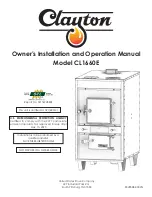
5
CAUtioN:
This furnace requires unrestricted airflow for
combustion and ventilation. For proper and
safe operation, it is extremely important that the
furnace receives an unobstructed flow of clean,
fresh air to properly burn the fuel gas. If this flow
of air is restricted, the partially burned combustion
gases may create dangerous amounts of carbon
monoxide that can cause personal injury or death.
• Do not block or obstruct air openings on the furnace, air
openings or spacings around the furnace area or the
room or closet the furnace is in. Furniture and drapery
should be arranged so that the supply air registers and
return grilles are not obstructed.
• If your furnace obtains its air through a pipe to the
outdoors, do not allow the inlet of the pipe to become
blocked. If the furnace is operated without adequate
air for combustion, the flame roll-out switch will open,
turning off the gas supply to the burners. This indicates
that a serious problem with the burners has occurred
and must be corrected immediately. Only a licensed
HVAC technician can reset this switch.
• Before remodeling near the furnace, consult with a
local code official or the National Fuel Gas Code to
make sure you will be in compliance with supplying
adequate air for combustion. By erecting new walls,
it is sometimes possible to inadvertently restrict the
furnace’s air supply. You can find more information
about supplying combustion air in the NFGC, which is
available at many libraries.
ClEARANCES to CoMBUStiBlES
wARNiNG:
Do not place combustible materials on or against
the furnace cabinet or within 6 inches of the vent
pipe. Furnace area must be kept clear and free
of combustible materials, gasoline and other
flammable vapors and liquids. A fire or explosion
may result causing property damage, personal
injury or loss of life. Failure to follow the safety
warnings exactly could result in serious injury,
death or property damage.
The furnace is designed to have certain clearances to
combustible items such as wood, paper, etc. Some types
of insulation are combustible. If your furnace is installed
in an attic, near unfinished walls, or in other insulated
space, keep area surrounding the furnace free of insulating
material.
SoURCES oF CoRRoSioN
It is known that certain common household chemicals can
cause heat exchanger corrosion if the vapors are pulled into
the furnace’s burners The following is a list of chemicals
that should not be used or stored near the furnace.
Do not store these chemicals near the furnace:
• Permanent wave solutions
• Chlorinated waxes and cleaners
• Chlorine based swimming pool chemicals
• Water softening chemicals
• De-icing salts or chemicals
• Carbon tetrachloride
• Halogen type refrigerants
• Cleaning solvents (perchloroethylene)
• Printing inks, paint removers, varnishes, etc.
• Hydrochloric acid
• Cements and glues
• Antistatic fabric softeners
• Masonry acid washing materials
FiltER
wARNiNG:
Never operate the furnace without a filter in place.
Accumulating dust in the return air can build
up on internal components, resulting in loss of
efficiency, equipment damage, and possible fire.
Keep air filters cleaned. Clean or replace filter to maintain
proper airflow and achieve maximum efficiency. Refer to
page 11 for Maintenance & Inspection information.
Flood dAMAGE
wARNiNG:
Do not use this furnace if any part has been under
water. A flood damaged furnace is extremely
dangerous. Attempts to use the furnace can result
in fire or explosion. A qualified service agency
should be contacted to inspect the furnace and
to replace all gas controls, control system parts,
electrical parts that have been wet or the furnace
if deemed necessary.
iMPoRtANt SAFEtY iNFoRMAtioN






































